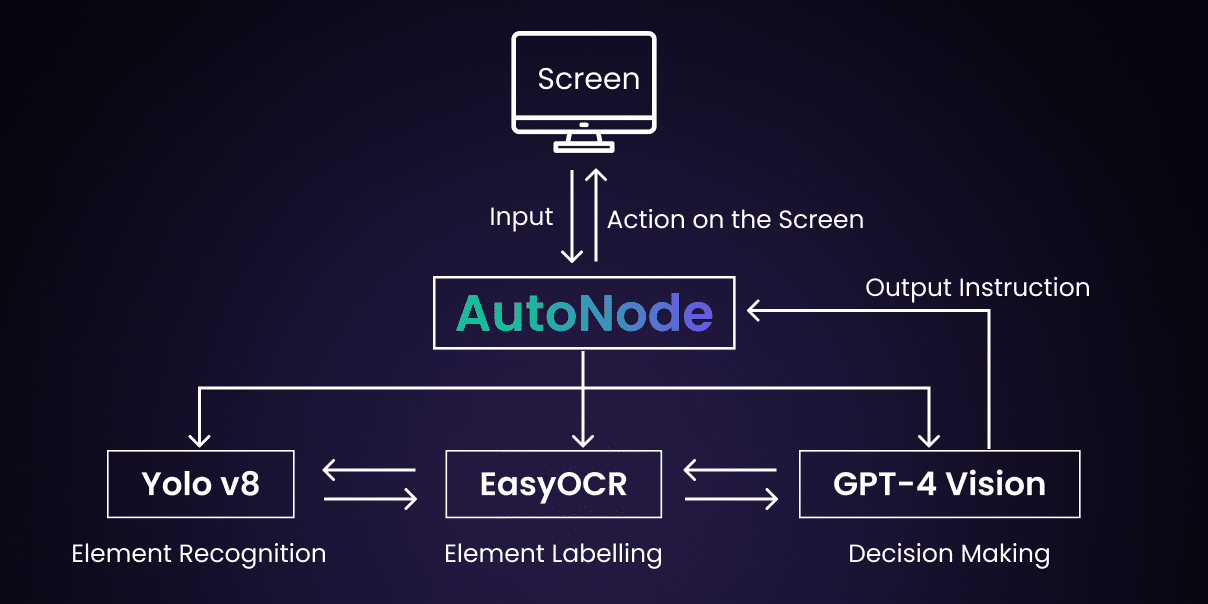AutoNode is a significant progression in Robotic Process Automation (RPA), addressing the limitations of current systems through a synergistic integration of specialized AI models. This solution targets the inefficiencies and inaccuracies prevalent in existing RPA technologies.
Shortcomings in current RPA/Self-Operating Computers:
Conventional RPA systems face several challenges:
- Inaccurate mouse click locations due to limited understanding of UI elements.
- Unreliable HTML parsing can result in noisy and inefficient automation.
- Due to dependency on static HTML structures, scripts can fail when UI changes.
How does AutoNode solve these?
The application of Robotic Process Automation (RPA) is highly sensitive to failures. To enhance fault tolerance and reduce the likelihood of such failures, We are using multiple specialized models instead of just relying on one. Each model, or ‘expert,’ would have a distinct role:
- The first expert’s role(Yolov8 model) is to identify clickable and interactive elements on the screen.
- The second expert’s job (easyOCR) is to categorize these clickable items, providing context for their functions or purposes.
- The final expert(GPT-4V) is responsible for deciding which element to interact with or take action on.
This multi-expert approach ensures a more robust and reliable RPA system.
The AutoNode Solution:
AutoNode introduces a multi-expert system, each expert being a specialized AI model addressing specific aspects of RPA:
1. YOLOv8 for Element Recognition
YOLOv8, a state-of-the-art object detection model, serves as the element recognition expert. Its technical advantages include:
- High Precision Detection: Superior at identifying interactive elements like buttons and text boxes.
- Efficient Training: Requires fewer images for training, reducing resource overhead.
- Speed and Deployment: Offers rapid processing and can be deployed locally for real-time applications.

If you want to peer into the code yourself, check out the YOLOv8 repository and view this code differential to see how some of the research was done.
2. Optical Character Recognition (OCR) for Labeling
We are utilizing EasyOCR alongside YOLOv8 to enhance text interpretation related to UI elements. Key features include:
- Text Analysis: Reads text around UI elements to understand their functionality.
- Dynamic Contextual Understanding: Provides a flexible approach to interact with UI elements, independent of HTML changes.
The initial step of OCR involves using a scanner to digitize the document. After all pages have been scanned, OCR software transforms the document into a two-tone, black and white, version. The scanned image or bitmap is examined for light and dark areas. The dark areas are identified as characters for recognition, while light areas are considered background. The dark areas are further processed to identify letters or numbers. While OCR programs vary in their techniques, they typically analyze one character, word or text block at a time. Characters are recognized using pattern recognition and feature detection.
For a detailed view of the research process, you can visit the EasyOCR repository and check out the code differential.
3. GPT-4Vision for Decision Making
GPT-4V is tasked with determining which UI element to interact with or act upon. It evaluates the context and functions of various elements displayed on the screen. By utilizing its advanced language comprehension and decision-making abilities, it chooses the most suitable action for any given situation.
GPT-4Vision synthesizes the data from YOLOv8 and OCR to make informed decisions:
- Intelligent Interaction: Determines the most appropriate UI element for interaction.
- Adaptive Learning: Continuously improves decision-making based on past interactions.
GPT-4 Vision’s ability to answer visual questions combines technologies such as image analysis, text recognition from images, and modular reasoning. These capabilities provide users with insights and information from a wide array of visual inputs. As such, GPT-4 Vision proves to be an invaluable tool in various fields.
Explore detailed insights into GPT-4 Vision by checking out the information provided in the OpenAI platform documentation at https://platform.openai.com/docs/guides/vision.
Achievements
We applied AutoNode to a complex web navigation task, traditionally challenging for RPA due to dynamic content and layout changes. The results were remarkable:
- Enhanced Accuracy: The precision of interactions increased significantly, reducing errors in clicking-rate by over 65% compared to traditional RPA systems.
- Adaptability: AutoNode successfully adapted to UI changes without requiring manual script updates, showcasing its resilience.
- Efficiency: The overall task completion time was reduced by 40%, demonstrating the efficiency of the integrated system.
In the below example, we are using AutoNode to navigate through a Gmail inbox, find the latest unread email, understand the context & respond to it.
Summary
In conclusion, AutoNode represents a significant improvement in RPA. By leveraging the strengths of YOLOv8, OCR, and GPT-4Vision, it addresses the core issues plaguing current RPA systems. This multi-expert approach ensures not only precision but also adaptability and efficiency, paving the way for more robust and intelligent automation solutions in various industries. AutoNode’s successful application in web navigation tasks is just the beginning of its potential impact in the field of RPA.
Read the complete research paper: https://arxiv.org/abs/2403.10171
Checkout the code on GitHub: https://github.com/TransformerOptimus/AutoNode

